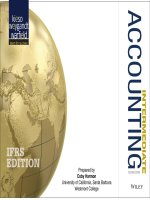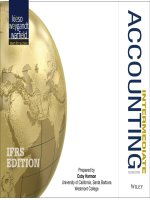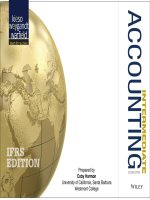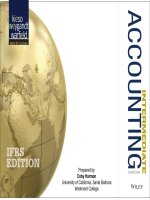Lecture Intermediate accounting (IFRS 2nd edition): Chapter 18 - Kieso, Weygandt, Warfield
Bạn đang xem bản rút gọn của tài liệu. Xem và tải ngay bản đầy đủ của tài liệu tại đây (2.92 MB, 132 trang )
18-1
PREVIEW OF CHAPTER
18
Intermediate Accounting
IFRS 2nd Edition
Kieso, Weygandt, and Warfield
18-2
18
Revenue Recognition
LEARNING OBJECTIVES
After studying this chapter, you should be able to:
1. Understand revenue recognition
issues.
6. Allocate the transaction price to the
separate performance obligations.
2. Identify the five steps in the revenue
recognition process.
7. Recognize revenue when the company
satisfies its performance obligation.
3. Identify the contract with customers.
8. Identify other revenue recognition
issues.
4. Identify the separate performance
obligations in the contract.
5. Determine the transaction price.
18-3
9. Describe presentation and disclosure
regarding revenue.
OVERVIEW OF REVENUE RECOGNITION
Background
Revenue recognition is a top fraud risk and regardless
of the accounting rules followed (IFRS or U.S. GAAP),
the risk or errors and inaccuracies in revenue reporting is
significant.
Recently, the IASB and FASB issued a converged
standard on revenue recognition entitled Revenue from
Contracts with Customers.
18-4
LO 1
OVERVIEW OF REVENUE RECOGNITION
New Revenue Recognition Standard
Revenue from Contracts with Customers, adopts an
assetliability approach. Companies:
uAccount for revenue based on the asset or liability arising
from contracts with customers.
uAre required to analyze contracts with customers
18-5
►
Contracts indicate terms and measurement of
consideration.
►
Without contracts, companies cannot know whether
promises will be met.
LO 1
New Revenue Recognition Standard
ILLUSTRATION 181 Key Concepts of Revenue Recognition
18-6
Performance Obligation is Satisfied
LO 1
18
Revenue Recognition
LEARNING OBJECTIVES
After studying this chapter, you should be able to:
1. Understand revenue recognition issues.
2. Identify the five steps in the
revenue recognition process.
3. Identify the contract with customers.
4. Identify the separate performance
obligations in the contract.
5. Determine the transaction price.
18-7
6. Allocate the transaction price to the
separate performance obligations.
7. Recognize revenue when the company
satisfies its performance obligation.
8. Identify other revenue recognition
issues.
9. Describe presentation and disclosure
regarding revenue.
THE FIVESTEP PROCESS
Assume that Airbus (FRA) Corporation signs a contract to sell
airplanes to Cathay Pacific Airlines (HKG) for €100 million.
ILLUSTRATION 182
Five Steps of Revenue Recognition
Step 1: Identify the
contract with
customers.
A contract is an agreement between two parties
that creates enforceable rights or obligations. In
this case, Airbus has signed a contract to deliver
airplanes to Cathay Pacific.
Step 2: Identify the
separate performance
obligations in the
contract.
Airbus has only one performance obligation—to
deliver airplanes to Cathay Pacific. If Airbus also
agreed to maintain the planes, a separate
performance obligation is recorded for this
promise.
18-8
LO 2
THE FIVESTEP PROCESS
ILLUSTRATION 182 Five Steps of Revenue Recognition
Step 3: Determine
the transaction
price.
Transaction price is the amount of consideration
that a company expects to receive from a
customer in exchange for transferring a good or
service. In this case, the transaction price is
straightforward—it is €100 million.
Step 4: Allocate the
transaction price to
the separate
performance
obligations.
In this case, Airbus has only one performance
obligation—to deliver airplanes to Cathay Pacific.
18-9
LO 2
THE FIVESTEP PROCESS
ILLUSTRATION 182 Five Steps of Revenue Recognition
Step 5: Recognize
revenue when
each performance
obligation
is satisfied.
18-10
Airbus recognizes revenue of €100 million for the
sale of the airplanes to Cathay Pacific when it
satisfies its performance obligation—the delivery of
the airplanes to Cathay Pacific.
LO 2
18
Revenue Recognition
LEARNING OBJECTIVES
After studying this chapter, you should be able to:
1. Understand revenue recognition issues.
2. Identify the five steps in the revenue
recognition process.
3. Identify the contract with
customers.
4. Identify the separate performance
obligations in the contract.
5. Determine the transaction price.
18-11
6. Allocate the transaction price to the
separate performance obligations.
7. Recognize revenue when the company
satisfies its performance obligation.
8. Identify other revenue recognition
issues.
9. Describe presentation and disclosure
regarding revenue.
Identify Contract with Customers—Step 1
Contract:
uAgreement between two or more parties that creates
enforceable rights or obligations.
uCan be
►
written,
►
oral, or
►
implied from customary business practice.
Company applies the revenue guidance to a contract
according to the following criteria in Illustration 183.
18-12
LO 3
Contract with Customers—Step 1
ILLUSTRATION 183 Contract Criteria for Revenue Guidance
Apply Revenue Guidance to Contracts If:
§
§
§
§
§
18-13
The contract has commercial substance;
The parties to the contract have approved the
contract and are committed to perform their
respective obligations;
The company can identify each party’s rights
regarding the goods or services to be
transferred; and
The company can identify the payment terms
for the goods and services to be transferred.
It is probable It is probable that the company
will collect the consideration to which it will be
entitled.
Disregard Revenue
Guidance to Contracts If:
§
§
The contract is wholly
unperformed, and
Each party can unilaterally
terminate the contract
without compensation.
LO 3
Contract with Customers—Step 1
Basic Accounting
uRevenue cannot be recognized until a contract exists.
uCompany obtains rights to receive consideration and
assumes obligations to transfer goods or services.
uRights and performance obligations gives rise to an (net)
asset or (net) liability.
uCompany does not recognize contract assets or liabilities until
one or both parties to the contract perform.
Contract asset = Rights received > Performance obligation
Contract liability = Rights received < Performance obligation
18-14
LO 3
Basic Accounting
ILLUSTRATION 184
Basic Revenue Transaction
CONTRACTS AND RECOGNITION
Facts: On March 1, 2015, Margo Company enters into a contract to transfer a
product to Soon Yoon on July 31, 2015. The contract is structured such that Soon
Yoon is required to pay the full contract price of HK$5,000 on August 31,
2015.The cost of the goods transferred is HK$3,000. Margo delivers the product
to Soon Yoon on July 31, 2015.
Question: What journal entries should Margo Company make in regards to
this contract in 2015?
The journal entry to record the sale and related cost of goods sold is as follows.
July 31, 2015
Accounts Receivable
5,000
Sales Revenue
5,000
18-15
Cost of Goods Sold
3,000
LO 3
Basic Accounting
ILLUSTRATION 184
Basic Revenue Transaction
CONTRACTS AND RECOGNITION
Facts: On March 1, 2015, Margo Company enters into a contract to transfer a
product to Soon Yoon on July 31, 2015. The contract is structured such that Soon
Yoon is required to pay the full contract price of HK$5,000 on August 31,
2015.The cost of the goods transferred is HK$3,000. Margo delivers the product
to Soon Yoon on July 31, 2015.
Question: What journal entries should Margo Company make in regards to
this contract in 2015?
Margo makes the following entry to record the receipt of cash on August 31, 2015.
August 31, 2015
Cash
5,000
Accounts Receivable
5,000
18-16
LO 3
Contract with Customers—Step 1
Contract Modifications
uChange in contract terms while it is ongoing.
uCompanies determine
18-17
►
whether a new contract (and performance
obligations) results or
►
whether it is a modification of the existing contract.
LO 3
Contract Modifications
Separate Performance Obligation
uAccount for as a new contract if both of the following
conditions are satisfied:
18-18
►
Promised goods or services are distinct (i.e.,
company sells them separately and they are not
interdependent with other goods and services), and
►
The company has the right to receive an amount of
consideration that reflects the standalone selling
price of the promised goods or services.
LO 3
Separate Performance Obligation
For example, Crandall Co. has a contract to sell 100 products to a
customer for $10,000 (€100 per product) at various points in time
over a sixmonth period. After 60 products have been delivered,
Crandall modifies the contract by promising to deliver 20 more
products for an additional €1,900, or €95 per product (which is the
standalone selling price of the products at the time of the contract
modification). Crandall regularly sells the products separately.
Given a new contract, Crandall recognizes an additional:
Original contract [(100 units 60 units) x €100] =
New product (20 units x €95) =
Total revenue
18-19
€4,000
1,900
€5,900
LO 3
Contract Modifications
Prospective Modification
uCompany should
18-20
►
account for effect of change in period of change as
well as future periods if change affects both.
►
not change previously reported results.
LO 3
Prospective Modification
For Crandall, the amount recognized as revenue for each of the
remaining products would be a blended price of €98.33, computed
as shown in Illustration 185.
Products not delivered under original contract
($100 x €40) =
€4,000
Products to be delivered under contract
modification (€95 x 20) =
18-21
LO 3
Prospective Modification
Under the prospective approach, a blended price (€98.33) is used
for sales in the periods after the modification.
ILLUSTRATION 186
Comparison of Contract Modification Approaches
18-22
LO 3
18
Revenue Recognition
LEARNING OBJECTIVES
After studying this chapter, you should be able to:
1. Understand revenue recognition issues.
2. Identify the five steps in the revenue
recognition process.
3. Identify the contract with customers.
4. Identify the separate performance
obligations in the contract.
5. Determine the transaction price.
18-23
6. Allocate the transaction price to the
separate performance obligations.
7. Recognize revenue when the company
satisfies its performance obligation.
8. Identify other revenue recognition
issues.
9. Describe presentation and disclosure
regarding revenue.
Separate Performance Obligations—Step 2
Revenue Recognition Situations
ILLUSTRATION 187
Type of
Transaction
Sale of product
from inventory
Performing a
service
Permitting use of
an asset
Sale of asset
other than
inventory
Description
of Revenue
Revenue from
sales
Revenue from
fees or services
Revenue from
interest, rents,
and royalties
Gain or loss on
disposition
Timing of
Revenue
Recognition
Date of sale (date
of delivery)
Services
performed and
billable
As time passes
or assets are
used
Date of sale or
tradein
18-24
LO 4
Separate Performance Obligations—Step 2
uTo determine whether a company has to account for
multiple performance obligations, it evaluates a
second condition.
uWhether the product is distinct within the contract.
18-25
►
If performance obligation is not highly dependent on,
or interrelated with, other promises in the contract,
then each performance obligation should be
accounted for separately.
►
If each of these services is interdependent and
interrelated, these services are combined and
reported as one performance obligation.
LO 4









